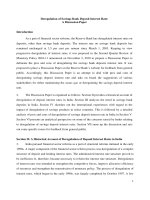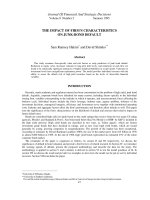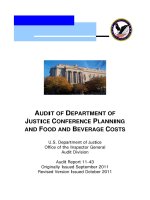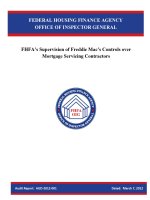FHFA''''S SUPERVISION OF FREDDIE MAC''''S CONTROLS OVER MORTGAGE SERVICING CONTRACTORS pptx
Bạn đang xem bản rút gọn của tài liệu. Xem và tải ngay bản đầy đủ của tài liệu tại đây (4.37 MB, 44 trang )
Federal Housing Finance Agency Office of Inspector General • AUD-2012-001 • March 7, 2012
4
TABLE OF CONTENTS
TABLE OF CONTENTS 4
ABBREVIATIONS 6
PREFACE 7
BACKGROUND 9
About the Enterprises and FHFA 9
Mortgages Owned or Guaranteed by Freddie Mac 9
Overview of Mortgage Servicing 10
What is Mortgage Servicing? 10
Concentration of Mortgage Servicers 11
Why Is Mortgage Servicer Performance Important? 12
What Is Freddie Mac Doing to Oversee Servicing? 15
Servicer Oversight and Performance Rating 15
Servicing Initiative to Minimize Credit Losses 16
What Are Other Federal Regulators Doing to Oversee Servicing? 17
What Is FHFA Doing to Oversee Servicing? 18
FHFA’s Statutory Responsibility for Overseeing the Enterprises 18
FHFA’s Authority over Mortgage Servicers 19
History of FHFA’s Supervision of Mortgage Servicing 20
FINDINGS 22
1. FHFA Needs to Strengthen Its Supervision of the Enterprises by Establishing a More Robust Counterparty
Oversight and Risk Management Framework 22
Contracting with Servicers 22
Reporting Critical Servicer Information 24
Establishing Mortgage Servicing Baseline Requirements 25
2. Improvements Started in 2011 by Freddie Mac to Address Servicer Performance Should Be Followed
Through 26
3. FHFA’s Examination Coverage of Freddie Mac’s Oversight and Risk Management of Counterparties
Needs Improvement 27
FHFA’s Delayed Examination Activities 28
FHFA’s Assessment of Freddie Mac’s Third-Party Risk 29
CONCLUSION 32
RECOMMENDATIONS 33
Federal Housing Finance Agency Office of Inspector General • AUD-2012-001 • March 7, 2012
5
SCOPE AND METHODOLOGY 34
Appendix A 36
FHFA’s Comments on Findings and Recommendations 36
Appendix B 40
FHFA-OIG’s Response to FHFA’s Comments 40
Appendix C 42
Summary of Management’s Comments on the Recommendations 42
ADDITIONAL INFORMATION AND COPIES 44
Federal Housing Finance Agency Office of Inspector General • AUD-2012-001 • March 7, 2012
6
ABBREVIATIONS
DER Division of Enterprise Regulation
Fannie Mae Federal National Mortgage Association
FDIC Federal Deposit Insurance Corporation
FHFA or Agency Federal Housing Finance Agency
FHFA-OIG Federal Housing Finance Agency Office of Inspector General
Freddie Mac Federal Home Loan Mortgage Corporation
FRS Federal Reserve System
GSE Government-Sponsored Enterprise
HERA Housing and Economic Recovery Act of 2008
HUD U.S. Department of Housing and Urban Development
MBS Mortgage Backed Securities
MOU Memorandum of Understanding
OCC Office of the Comptroller of the Currency
OCR Office of Credit Risk
OFHEO Office of Federal Housing Enterprise Oversight
OTS Office of Thrift Supervision
PFR Primary Federal Regulator
REO Real Estate Owned
TBW Taylor, Bean &Whitaker Mortgage Corp.
Treasury U.S. Department of the Treasury
UPB Unpaid Principal Balance
Federal Housing Finance Agency Office of Inspector General • AUD-2012-001 • March 7, 2012
7
Federal Housing Finance Agency
Office of Inspector General
Washington, DC
PREFACE
FHFA-OIG was established by HERA,
1
which amended the Inspector General Act of 1978.
2
FHFA-OIG is authorized to conduct audits, investigations, and other activities of the programs
and operations of FHFA; to recommend policies that promote economy and efficiency in the
administration of such programs and operations; and to prevent and detect fraud and abuse in
them.
The objective of this performance audit was to assess whether FHFA has an effective
supervisory control structure and sufficient examination coverage and oversight activities to
adequately and timely identify and mitigate risks related to Freddie Mac’s controls over
mortgage servicing contractors.
The audit noted opportunities for further improving FHFA’s supervision of the Enterprises’
controls over mortgage servicing contractors. Specifically, FHFA needs to continue to
(a) identify opportunities to enhance its regulations or guidance to the Enterprises regarding
counterparty contracting for mortgage servicing, including a contract provision authorizing
FHFA’s access to servicer information; and (b) consider additional efforts to enhance FHFA’s
supervision of Freddie Mac’s oversight of its mortgage servicing contractors.
FHFA-OIG believes that the recommendations in this report will help the Agency develop and
adopt more economical, effective, and efficient operations. FHFA-OIG appreciates the
assistance of all those who contributed to the audit.
This audit was led by Heath Wolfe, Audit Director, who was assisted by Menjie Medina, Audit
Manager.
1
Public Law No. 110-289.
2
Public Law No. 95-452.
Federal Housing Finance Agency Office of Inspector General • AUD-2012-001 • March 7, 2012
8
This report has been distributed to Congress, the Office of Management and Budget, and others
and will be posted on FHFA-OIG’s website, .
Russell A. Rau
Deputy Inspector General for Audits
Federal Housing Finance Agency Office of Inspector General • AUD-2012-001 • March 7, 2012
9
BACKGROUND
About the Enterprises and FHFA
On July 30, 2008, HERA was enacted and it made FHFA the regulator of the housing-related
government-sponsored enterprises (GSEs): Fannie Mae, Freddie Mac, and the Federal Home
Loan Banks. FHFA’s mission is to promote the GSEs’ safety and soundness, support housing
finance and affordable housing goals, and facilitate a stable and liquid mortgage market. HERA
also expanded the authority of the U.S. Department of the Treasury (Treasury) to provide
financial support to the Enterprises.
On September 6, 2008, FHFA became conservator of Fannie Mae and Freddie Mac, and at the
same time Treasury began providing the Enterprises with substantial financial support.
3
As
conservator, FHFA preserves and conserves the assets of the Enterprises, ensures that they focus
on their housing mission, and facilitates their financial stability and emergence from
conservatorships.
On October 12, 2010, FHFA’s first Inspector General, Steve A. Linick, was sworn in and
FHFA-OIG commenced operations. This audit followed and covers the time period from
January 1, 2010, through May 31, 2011 (the period was expanded as necessary).
4
Mortgages Owned or Guaranteed by Freddie Mac
Freddie Mac (along with Fannie Mae) is in the business of supporting the secondary residential
mortgage market by purchasing millions of home mortgages originated by banks and other
financial institutions. Mortgage sellers may use the sales proceeds received from the Enterprises
to fund additional loans to borrowers. The Enterprises pool most of these mortgages into
mortgage backed securities (MBS) for sale to investors, and provide credit guarantees on the
MBS. They also hold mortgages in their investment portfolios.
As of June 30, 2011, Freddie Mac owned or guaranteed 11,954,353 single-family mortgages,
with a combined UPB of nearly $1.8 trillion. Although 92% of these mortgages are fixed rate
3
Treasury provides financial support to the Enterprises by purchasing their preferred stock pursuant to Senior
Preferred Stock Purchase Agreements. As of the third quarter of 2011, Treasury had provided approximately $183
billion to the Enterprises.
4
Because FHFA’s policies, procedures, and controls for supervising Fannie Mae’s mortgage servicing contractors
are the same as those applicable to Freddie Mac, the audit issues identified in this report can generally apply to both
of the Enterprises.
Federal Housing Finance Agency Office of Inspector General • AUD-2012-001 • March 7, 2012
10
mortgage loan products, 32% of them are non-traditional loans.
5
The majority of Freddie Mac’s
non-traditional loans in its portfolio were originated and purchased during the 2004 – 2007
housing boom. Those loans have a higher risk than traditional fixed rate mortgages and, with the
end of the housing boom and continuing fragility in the housing market, have a greater
propensity to default. Such defaults have caused billions of dollars of credit losses to date to the
Enterprises and will continue to pose a credit risk for them. Whether these loans default is
critical to the Enterprises’ ongoing operations, and the rate of default is influenced by the quality
of loan servicing.
Overview of Mortgage Servicing
What is Mortgage Servicing?
With respect to the loans that the Enterprises guarantee or hold in their portfolios, they enter into
contracts with mortgage servicing companies to manage the day-to-day servicing of the loans.
6
These mortgage servicers perform a variety of duties for the Enterprises, including:
Collecting mortgage payments and processing late payments;
Sending periodic statements to borrowers;
Maintaining escrow accounts to pay property taxes and insurance;
Forwarding payments to mortgage owners; and
Handling default proceedings and foreclosures.
7
The mortgage servicers are typically compensated on the basis of a percentage of the UPB of the
mortgage loans that they manage.
Both Enterprises have developed their own mortgage servicer guides, which outline the
servicers’ duties and responsibilities.
8
These servicer guides are incorporated by reference in the
5
Non-traditional mortgage products include interest-only, Alt-A, and option adjustable rate mortgages, and loan
categories are not mutually exclusive.
6
Mortgage servicing companies are also called servicers, mortgage servicers, or mortgage servicing contractors.
Further, servicers can be insured depository institutions, such as banks, or non-banking institutions, such as
mortgage companies.
7
Mortgage servicers fall into one of two groups: servicers or seller/servicers. Mortgage servicers that do not
originate loans but service loans for the Enterprises often are called servicers. Mortgage servicers that sell and
service loans for the Enterprises frequently are called seller/servicers.
8
The Enterprises’ requirements for selling and servicing mortgages are incorporated in the same documents. For
purposes of this report, only the servicing requirements are relevant.
Federal Housing Finance Agency Office of Inspector General • AUD-2012-001 • March 7, 2012
11
Enterprises’ servicing contracts. The Enterprises’ respective mortgage servicer guides generally
contain similar topical areas, but their specific requirements vary. For example, prior to the
implementation of FHFA’s Servicing Alignment Initiative,
9
Freddie Mac and Fannie Mae
required significantly different procedures for servicing delinquent mortgages.
10
Fannie Mae’s
and Freddie Mac’s foreclosure timelines differed both in the terms of unit of measurement (i.e.,
months vs. days) and actual goals (e.g., Fannie Mae’s goal for Kansas was 4 months and Freddie
Mac’s goal was 180 days). Foreclosure timelines have been unified with the implementation of
the Servicing Alignment Initiative.
Due to the sheer volume of approved servicers, the Enterprises largely accept in good faith that
the servicers are managing loans in accordance with the Enterprises’ servicing guides. However,
if the Enterprises suffer a credit related loss and they discover that the servicers did not follow
one or more of their requirements, then they may seek a remedy to mitigate their losses. These
remedies may include requiring a servicer to purchase a loan at its current UPB or make an
Enterprise whole for any credit losses realized with respect to a loan.
Concentration of Mortgage Servicers
As of June 30, 2011, Freddie Mac had 1,457 mortgage servicers.
11
For the same time period,
Fannie Mae had 1,498 mortgage servicers and a loan portfolio of $2.7 trillion.
In contrast to the large number of servicers it employs, the majority of Freddie Mac’s loan
portfolio is serviced by a select few servicers. As of June 30, 2011, the market share of Freddie
9
On April 28, 2011, FHFA introduced the Servicing Alignment Initiative, which seeks to establish consistent,
transparent standards for servicing delinquent mortgage loans that the Enterprises own or guarantee. See FHFA,
Fannie Mae and Freddie Mac to Align Guidelines for Servicing Delinquent Mortgages (Apr. 28, 2011), available at
www fhfa.gov/webfiles/21190/SAI42811Final.pdf. The new directive includes cash incentives for exemplary
performance, as well as monetary penalties for underperformance. It addresses four aspects of delinquent loan
servicing: borrower contact, delinquency management practices, loan modifications, and foreclosure timelines.
With respect to loan modifications, the servicers are required to conform their performance to guidelines previously
published by the Enterprises. See, e.g., Fannie Mae, Servicing Guide Announcement SVC 2011-03: Updates to
Fannie Mae’s Mortgage Modification Requirements (Apr. 4, 2011). Fannie Mae’s guidelines provide standards for
evaluating borrowers for modifications, permissible lengths for modification trial periods, documentation
requirements, and credit bureau reporting. According to FHFA, the Servicing Alignment Initiative is intended to
provide superior service to borrowers with clearer and more consistent borrower communications, efficient
processing of loan modifications, a fair foreclosure process, increased servicer accountability, and, ultimately,
reduced taxpayer losses through improved loan servicing.
10
An inter-agency effort among the federal regulators – the Office of the Comptroller of the Currency, Federal
Reserve System, Federal Deposit Insurance Corporation, FHFA, and the Bureau of Consumer Financial Protection –
is under way to create a comprehensive set of national servicing standards for the industry, but the implementation
date of this initiative is yet to be determined as of February 2012.
11
Using Freddie Mac’s servicer account numbers, the total number of servicers is 1,457. However, numerous
servicers have affiliates or subsidiaries that perform servicing duties, and when these affiliated entities are grouped
together the number of distinct servicer “families” totals 1,215.
Federal Housing Finance Agency Office of Inspector General • AUD-2012-001 • March 7, 2012
12
Mac’s four largest mortgage servicers (i.e., Wells Fargo, Bank of America, JPMorgan Chase,
and Citigroup) was 60% (i.e., $1.07 trillion of the nearly $1.8 trillion in UPB).
12
Moreover, the
10 largest servicers manage 80% of Freddie Mac’s and 76% of Fannie Mae’s loan portfolio,
respectively. Additionally, Freddie Mac and Fannie Mae do business with many of the same
servicers. According to the Enterprises’ records, approximately 333 servicers work for both of
the Enterprises. These servicers manage 84% (i.e., $1.5 trillion) of Freddie Mac’s and 81% (i.e.,
$2.2 trillion) of Fannie Mae’s loan portfolios, respectively. The significant amount of servicing
business concentrated among so few servicers poses a safety and soundness concern to the
Enterprises. If one or more of the largest servicers were to cease servicing operations, or if the
Enterprises were to transfer servicing rights, they could find it difficult to obtain alternative
servicers capable of handling a large amount of business. Moreover, servicers with a heightened
degree of supervisory concern (i.e., a CAMELS rating of “3” or above)
13
manage 30% of Freddie
Mac’s loan portfolio (i.e., $541 billion of the nearly $1.8 trillion in UPB).
Why Is Mortgage Servicer Performance Important?
From the onset of the Enterprises’ conservatorships in September 2008 to the third quarter of
2011, Treasury has invested $183 billion in them.
14
This financial support is needed to prevent
their insolvency and offset their losses, which have been historically high in the past three years.
Figure 1 on the next page shows the Enterprises’ annual revenues, credit-related losses, and
withdrawals of funds from Treasury during the conservatorships.
12
Fannie Mae’s experience was nearly identical in terms of its largest servicers (i.e., Bank of America, Wells Fargo,
JPMorgan Chase, and Citigroup) and their market share (i.e., 61%: $1.643 trillion of the $2.703 trillion in UPB).
13
The federal banking regulators conduct examinations of the banking institutions under their purview and assign
CAMELS ratings to them based on the results of their examinations. The components of CAMELS ratings are:
Capital adequacy, Asset quality, Management, Earnings, Liquidity, and Sensitivity to market risk. CAMELS
ratings range from 1 to 5 with 1 being the strongest and 5 being the weakest. A rating of 3 or higher denotes
institutions with a heightened degree of supervisory concern.
14
FHFA projects that Treasury’s investment in the Enterprises will increase to between $220 billion and $311
billion through the close of calendar year 2014. The Federal Reserve also took steps to support the Enterprises, such
as purchasing up to $1.14 trillion of their securities as of December 31, 2011.
Federal Housing Finance Agency Office of Inspector General • AUD-2012-001 • March 7, 2012
15
Given these trends, mortgage servicing is critically important to the financial health of the
Enterprises. And, as discussed below, Freddie Mac has concluded that modest improvements in
servicing, such as increasing the percentage of delinquent loans that are successfully modified
and avoiding foreclosure, can reduce credit losses.
What Is Freddie Mac Doing to Oversee Servicing?
Servicer Oversight and Performance Rating
Prior to 2011, servicing oversight-related functions were dispersed throughout Freddie Mac’s
various business operations. In the third quarter of 2010, Freddie Mac created the Single Family
Portfolio Management Division as well as several new units to manage the performance of its
servicing portfolio and to oversee the management of its servicers. This was done to implement
a more holistic servicing approach, one that is capable of managing all aspects of the Enterprise’s
servicing portfolio including performing loans, non-performing loans, and real estate owned
(REO).
In July 2011, Freddie Mac also implemented its enhanced Servicer Success Scorecard, which
redefines Freddie Mac’s expectations of quality and responsible servicing. The Servicer Success
Scorecard replaced its Servicer Performance Tier rating in order to better measure servicer
performance in the current servicing environment. According to Freddie Mac’s Servicing
Success Program publication, dated August 2011, all servicers receive monthly scorecards,
which measure their performance against the established performance criteria. Additionally, for
servicers with large servicing books and high volume, their scorecard includes an additional
component of individualized objectives and goals as well as Freddie Mac’s Servicer Success
Account Plan.
23
A servicer’s performance is considered to be unacceptable if the servicer ranks
in the bottom 25% of all ranked servicers (after taking into account other factors such as
portfolio composition, concentration of high-risk mortgages, trends in performance, adequacy of
staffing, audit results, and compliance with the purchase documents).
24
In contrast with the
Servicer Performance Tier rating, servicers are not ranked against other servicers; instead, scores
in their respective performance rating categories are aggregated to arrive at their tier ratings.
23
Through account plans, Freddie Mac currently monitors servicers’ performance toward accomplishment of
Freddie Mac’s loan modification goals set out in its 2011 Business Plan (see below). However, to the extent that a
servicer has not been placed on an account plan, it is unclear if Freddie Mac is assessing servicers’ performance
against their target, and if so, according to what standard.
24
Freddie Mac Bulletin Number 2011-13, dated July 25, 2011.
Federal Housing Finance Agency Office of Inspector General • AUD-2012-001 • March 7, 2012
18
weaknesses in the mortgage servicers’ foreclosure governance processes, foreclosure document
preparation processes, and oversight and monitoring of third-party vendors, including foreclosure
attorneys. As a result of these deficiencies, the regulators took formal enforcement actions
against each of the mortgage servicers. The enforcement actions required the servicers to
improve their foreclosure processes. Further, the mortgage servicers have to conduct a more
complete review of certain aspects of foreclosure actions that were pending between January 1,
2009, and December 31, 2010, to identify borrowers that were financially harmed by the
deficiencies and to provide remediation to those borrowers where appropriate.
What Is FHFA Doing to Oversee Servicing?
FHFA’s Statutory Responsibility for Overseeing the Enterprises
FHFA is responsible for overseeing the prudential operations of the Enterprises and ensuring that
they operate in a safe and sound manner, including maintaining adequate capital and internal
controls.
33
FHFA uses a risk-based approach to ensure that the Enterprises operate in a safe and
sound manner. Each year, FHFA prepares an annual supervisory plan to document:
The specific areas that the Agency will focus on during the year; and
The examination activities that will be conducted to ensure that the Enterprises
operate in a safe and sound manner.
34
FHFA developed a Supervision Handbook, a Supervisory Guide, and Reference and Procedures
Manuals to describe its processes for supervising the Enterprises. The Supervision Handbook
explains the philosophy and methods used by the Agency in carrying out its mission, and the
Supervisory Guide provides a more detailed description of FHFA’s examination process. The
Reference and Procedures Manuals include general procedures for the examiners to follow to
determine whether the Enterprises are providing appropriate oversight over third parties, such as
mortgage servicers.
Additionally, the Enterprises are subject to regulations promulgated by FHFA and its
predecessor agency, the Office of Federal Housing Enterprise Oversight (OFHEO). No existing
regulations expressly govern counterparty contracting or third-party relationship risk
33
See 12 U.S.C. § 4513.
34
For purposes of this report, the term “supervisory plan” includes the supervisory strategies, examination plans,
and related documents that define the objectives, scope, and methodology for examination and monitoring activities
to be performed by FHFA at an individual GSE.
Federal Housing Finance Agency Office of Inspector General • AUD-2012-001 • March 7, 2012
19
management, but in June 2011 FHFA issued a proposed rule outlining requirements for
managing credit and counterparty – including servicers – risk.
35
In September 2008, FHFA placed the Enterprises into conservatorships. As conservator, FHFA
has the powers of the Enterprises’ management, boards of directors, and shareholders. Although
FHFA has very broad authority as conservator, FHFA does not manage every aspect of the
Enterprises’ operations. Rather, the Enterprises continue to operate as for-profit corporations,
continue to make public filings with the Securities and Exchange Commission, and are
responsible for their own day-to-day operations. When FHFA placed them into
conservatorships, it replaced and reconstituted the Enterprises’ boards of directors and charged
them with ensuring that normal corporate governance practices and procedures were in place.
The new boards are responsible for carrying out board functions, but they are subject to FHFA
review and approval of particular matters.
FHFA’s Authority over Mortgage Servicers
FHFA lacks express statutory authority to regulate directly the Enterprises’ mortgage servicers.
However, if a servicer is an “entity-affiliated party,”
36
the Agency can take enforcement action
against it, if needed, to protect the interests of the Enterprises, as follows:
37
If, in the opinion of the Director, a regulated entity or any entity-affiliated party is
engaging or has engaged, or the Director has reasonable cause to believe that the
regulated entity or any entity-affiliated party is about to engage in an unsafe or unsound
practice in conducting the business of the regulated entity or the Office of Finance, or is
violating or has violated, or the Director has reasonable cause to believe is about to
violate, a law, rule, regulation, or order, or any condition imposed in writing by the
Director in connection with the granting of any application or other request by the
regulated entity or the Office of Finance or any written agreement entered into with the
35
See 76 Fed. Reg. 35791 (June 20, 2011), available at />15100.pdf.
36
The term “entity-affiliated party” is defined to include agents for the Enterprises as well as any person, as
determined by the Director (by regulation or on a case-by-case basis) that participates in the conduct of affairs of a
regulated entity. See 12 U.S.C. § 4502(11).
37
Although FHFA does not have direct supervisory authority over the servicers, federal and state regulators have
authority over some servicers. For example, the federal banking regulators, such as OCC, FRS, and FDIC, have
explicit statutory authority over national banks, state member banks, and federally insured non-member state-
chartered banks and savings banks, respectively, and these entities service the majority of loans in the Enterprises’
portfolios.
Federal Housing Finance Agency Office of Inspector General • AUD-2012-001 • March 7, 2012
21
Furthermore, in response to the substantial increase in delinquent mortgages, FHFA has taken a
number of actions. For example, FHFA worked with the Enterprises and Treasury to implement
the Making Home Affordable programs, which were initiated to help millions of homeowners
avoid foreclosure. Moreover, FHFA is involved in interagency initiatives intended to create a
comprehensive set of uniform mortgage servicing standards. FHFA also directed the Enterprises
to: (1) implement a four point policy framework for handling foreclosure process deficiencies;
(2) align their guidelines for servicing delinquent mortgages; and (3) work on a joint initiative, in
coordination with FHFA and the U.S. Department of Housing and Urban Development (HUD),
to consider alternatives for future mortgage servicing compensation structures for single-family
mortgage loans.
Federal Housing Finance Agency Office of Inspector General • AUD-2012-001 • March 7, 2012
22
FINDINGS
FHFA-OIG finds that:
1. FHFA Needs to Strengthen Its Supervision of the Enterprises by
Establishing a More Robust Counterparty Oversight and Risk
Management Framework
Although it has undertaken affirmative measures, FHFA has not developed sufficient regulations
or guidance governing the Enterprises’ oversight and risk management of counterparties, such as
servicers. The Safety and Soundness Act generally requires FHFA to issue regulations,
guidance, and orders that are necessary to carry out its safety and soundness mission.
42
In
addition, the Safety and Soundness Act specifically requires that FHFA establish standards
relating to the management of credit and counterparty risks.
43
However, FHFA, unlike federal banking regulators, generally has not issued sufficient
regulations or guidance governing the Enterprises’ contracting with servicers. Specifically,
FHFA has not established and implemented effective Enterprise regulations or guidance
controlling:
Reporting critical servicer information; and
Establishing baseline requirements for mortgage servicing.
Instead, FHFA relies on the Enterprises individually to monitor counterparty risk as part of their
ongoing risk management activities. And, similar to FHFA’s reliance on Fannie Mae and
Freddie Mac, the Enterprises routinely rely on mortgage servicers to manage the loans in their
portfolios. Although reliance on servicers can assist the Enterprises to attain their strategic
objectives, it can also present risks if not properly managed.
Contracting with Servicers
Federal banking regulators have established comprehensive regulations or guidance that provide
a general framework for servicer oversight and risk management.
44
FHFA has not. FHFA
42
See 12 U.S.C. § 4526.
43
See 12 U.S.C. § 4513b.
44
See, e.g., OCC (OCC Bulletin 2001-47, Third Party Relationships) and the FDIC (Financial Institutions
Letter-44-2008, Guidance for Managing Third-Party Risk).
Federal Housing Finance Agency Office of Inspector General • AUD-2012-001 • March 7, 2012
23
should consider developing a comparable risk management framework to ensure that the
Enterprises implement effective risk management strategies.
Additionally, FHFA’s ability to supervise the Enterprises’ servicer risk may be impaired by its
lack of direct access to servicer books and records relating to the Enterprises’ approximately
$4.5 trillion servicing portfolio.
45
Although FHFA does not have express statutory authority to
regulate or supervise the servicers, there is no prohibition against the Agency securing such
access through contract.
46
As of September 2011, the Enterprises’ contract terms and conditions
– which FHFA has effectively had the ability to control since it became conservator in
September 2008 – did not provide FHFA with access to servicer information or with the ability
to ensure that servicers are complying with their servicing contracts.
FHFA should have access to the books and records of the servicers who contract with the
Enterprises for the following reasons:
To Fulfill FHFA’s Responsibility of Overseeing the Prudential Operations of the
Enterprises. FHFA recognizes its responsibility to supervise the operations of the
Enterprises, which rely on servicers to perform a variety of loan management
functions. When the Enterprises turn to servicers to perform their responsibilities, the
vendors’ activities should be subject to the same risk management monitoring that
FHFA would perform if the Enterprises were conducting the contracted activities
themselves. In other words, the Enterprises’ use of servicers to perform servicing
functions on their behalf should not diminish the responsibility of FHFA to ensure
that those servicing functions are conducted in a safe and sound manner and in
compliance with applicable laws.
To Support Enforcement Actions. FHFA has the authority to take enforcement
actions against the Enterprises’ mortgage servicers if it has reasonable cause to
believe that a servicer is engaging/has engaged/is about to engage in an unsafe or
unsound practice in conducting the business of the Enterprises or if a servicer is
violating/has violated/is about to violate a law, rule, or regulation. However, FHFA’s
45
As conservator of the Enterprises, FHFA – through the Enterprises – has access to the servicers’ books and
records since the Agency has the powers of Enterprise management. However, once the conservatorships are
terminated such access through the Enterprises is not assured, and, yet, it is equally important for FHFA to have this
access to servicer records in its supervisory/regulator capacity. Accordingly, FHFA needs to secure direct access
through contract or other means during the pendency of the conservatorships.
46
There is precedent for voluntary inclusion of access provisions for FHFA in the Enterprises’ contracts with their
vendors. The Enterprises have started incorporating an FHFA access provision in several of their REO contracts.
Freddie Mac has not included such provision in any of its servicing contracts.
Federal Housing Finance Agency Office of Inspector General • AUD-2012-001 • March 7, 2012
24
ability to implement this authority may be impaired without direct access to evidence
of unsound practices or non-compliance with applicable standards.
47
To Fill Oversight Gaps Associated with Servicers’ Activities. Not all servicers are
financial institutions necessarily supervised by PFRs. Therefore, without oversight
by FHFA, such servicers may be unsupervised.
To Ensure Safety and Soundness of the Enterprises. Although the PFRs, such as the
OCC, FRS, and FDIC, conduct examinations of institutions that service loans for the
Enterprises, the objectives of the federal bank regulators’ and FHFA’s examinations
will not always align. The PFRs primarily focus on the safety and soundness of
financial institutions (i.e., the servicers), whereas FHFA focuses on the safety and
soundness of the Enterprises (and, in its conservator capacity, the preservation and
conservation of their assets). For example, FHFA may be interested in acquiring
information about servicer controls designed to ensure compliance with Enterprise
servicing agreements, but other regulators may consider this area of inquiry to be
irrelevant to the subject servicer’s safety and soundness. Thus, inclusion of an FHFA
access provision in the servicing contracts will strengthen FHFA’s supervisory
control over the Enterprises and lessen FHFA’s reliance on the regulatory efforts of
other agencies.
Reporting Critical Servicer Information
FHFA also has not issued regulations or guidance requiring the Enterprises to report critical
servicer information to FHFA, but the issue is currently under consideration.
Given the Enterprises’ significant concentration of risk among a few servicers, FHFA needs to
receive timely and relevant information relating to the operation of these servicers. For example,
if a servicer is suspended or terminated due to poor performance or noncompliance with
guidelines by either Fannie Mae or Freddie Mac, the information should be promptly reported to
FHFA. In turn, FHFA should evaluate the report and assess whether the servicer poses a safety
and soundness concern and, if so, direct the other Enterprise to take appropriate action.
Reporting this critical information is crucial to FHFA’s overall assessment of the Enterprises’
risk profiles. As of September 2011, the Enterprises do not share with each other information
about servicers even though Fannie Mae and Freddie Mac use more than 300 of the same
servicers. Until FHFA requires the Enterprises to share performance and compliance data about
47
Although FHFA has authority to subpoena documents, it cannot subpoena servicers directly except in relation to
an ongoing proceeding or investigation. See 12 U.S.C. § 4641.
Federal Housing Finance Agency Office of Inspector General • AUD-2012-001 • March 7, 2012
25
their servicers, FHFA is at risk of not being timely informed of critical information that could
impact the Enterprises’ safety and soundness.
Establishing Mortgage Servicing Baseline Requirements
Unlike OCC and FDIC, FHFA has not implemented comprehensive regulations or guidance that
ensure the Enterprises clearly understand the potential risks that can arise from relationships with
their servicers and that they develop effective risk management strategies. Although FHFA’s
proposed rule outlining specific requirements for managing credit and counterparty risk is more
specific than procedures previously issued by OFHEO and FHFA, it does not provide to the
Enterprises comprehensive guidance concerning the monitoring of third parties. For example,
even though there is a requirement in the proposed rule for the Enterprises to have appropriately
trained and competent personnel to manage credit and counterparty risks, this requirement alone
is not sufficient without a robust framework for managing third-party relationship risks. This
framework should include a risk assessment to identify and prioritize counterparty risk; proper
due diligence to identify and select third-party providers; written contracts that outline duties,
obligations, and responsibilities of the parties involved; and ongoing oversight of the third parties
and third-party activities. This type of guidance is provided by other federal regulators, such as
the OCC and FDIC.
48
FHFA has not developed comprehensive guidelines because it believes that the Enterprises have
the knowledge and expertise to develop sufficient servicing guides. Thus, FHFA relies on them
to establish their own minimum mortgage servicing requirements. In 2011, however, FHFA
directed the Enterprises to establish requirements for servicing non-performing loans (also
known as the Servicing Alignment Initiative). But, FHFA has not required the Enterprises to
establish requirements for other aspects of servicing, such as servicing the larger subset of
performing loans.
49
Because the Enterprises have separately developed their own servicing guides, the Enterprises’
servicing requirements significantly differ in a number of respects, such as servicing delinquent
mortgages. FHFA’s Servicing Alignment Initiative, which aspires to align the servicing of
delinquent mortgages, is a step in the right direction, but FHFA should assume a more
affirmative role in determining the substance of mortgage servicing standards across the board.
48
See, e.g., OCC (OCC Bulletin 2001-47, Third Party Relationships) and the FDIC (Financial Institutions
Letter-44-2008, Guidance for Managing Third-Party Risk).
49
Activities relating to servicing performing loans include collecting mortgage payments and processing late
payments; sending periodic statements to borrowers; maintaining escrow accounts to pay property taxes and
insurance; and forwarding payments to mortgage owners.









